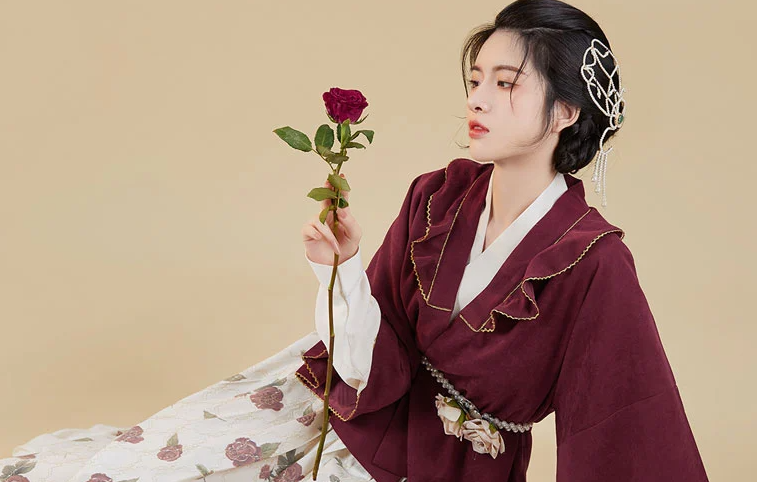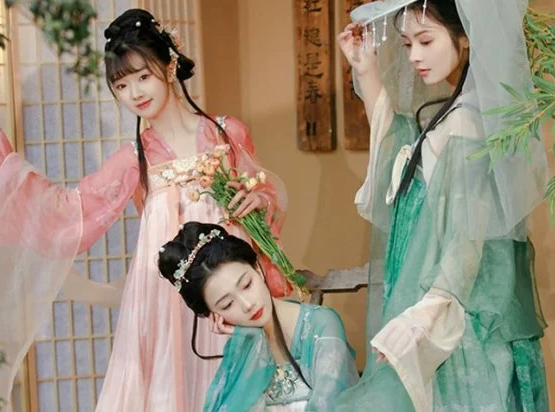Under Hanfu, people typically wear a combination of undergarments like Doupeng, Zhiduo, Mo, or Mianao, depending on factors such as gender, regional traditions, and personal preferences.
Historical Context
Evolution of Hanfu and Its Undergarments
Hanfu, the traditional clothing of the Han Chinese, has evolved over millennia. In the same vein, the undergarments worn beneath these elaborate outfits have undergone changes to meet the needs of various dynasties and fashions. Originally, during the Han dynasty, undergarments were simple, mostly consisting of a close-fitting garment called a “Dudou” that wrapped around the chest area. As time progressed, especially during the Ming and Qing dynasties, undergarments such as the Doupeng and Zhiduo became more popular. These offered not just modesty, but also an additional layer that helped to shape the Hanfu properly.
The types of materials used also changed over time. Initially, undergarments were primarily made of hemp or simple cotton. But as the silk road opened up, materials like silk started to be used for wealthier citizens, adding an element of luxury to the utility.

Regional Variations
Geography has played a crucial role in the kind of undergarments that are worn under Hanfu. In colder regions like Manchuria, thicker and padded undergarments were essential, sometimes made of layers of quilted fabric. In contrast, in the hotter southern regions, undergarments made from breathable materials like linen were more common.
Moreover, certain regions had unique stitching patterns or embroidery on undergarments. For instance, the Hunan province is known for its intricate needlework, which is often reflected in the local style of Hanfu and its corresponding undergarments.
Gender-Specific Undergarments
Traditionally, men and women wore different types of undergarments under their Hanfu. Men usually wore looser undergarments like Zhiduo, which were often sleeveless and less restrictive. Women, on the other hand, wore more fitted undergarments like Doupeng and Mianao that offered more support and helped shape the outer Hanfu garments.
Types of Undergarments
Doupeng (肚棚)
Doupeng, sometimes known as a belly cover, serves as a traditional Chinese undergarment, designed to be worn beneath Hanfu. It usually consists of a square or rectangular piece of cloth that covers the midriff and ties at the back. Made primarily of materials like cotton, silk, or linen, Doupeng acts as a shield between the skin and the outer garment, offering both comfort and modesty. This is especially important for preserving the quality of the outer Hanfu, as it minimizes direct contact with sweat and body oils. Women frequently opt for Doupeng with embroidered details, adding a personal touch to this otherwise utilitarian item. Doupengs have various symbolic motifs, such as dragons and phoenixes, symbolizing good luck and prosperity.
Zhiduo (直裰)
Zhiduo is a type of traditional Chinese undergarment commonly worn by men under their Hanfu. It resembles a long robe and often features an open cut that makes it easier to move around. Zhiduo usually is sleeveless or has very short sleeves, which helps to keep the wearer cool. While Zhiduo can be made from a variety of fabrics, cotton remains a popular choice for its breathability and comfort. In addition to its functional aspects, the Zhiduo may also carry simple yet meaningful patterns such as clouds or waves, symbolizing the constant flow of life.
Mo (抹)
Mo is a Chinese undergarment designed to be worn on the upper body. It is similar to a bandeau or tube top, wrapping around the chest area. Women typically wear Mo under their Hanfu to provide support and coverage. Lighter fabrics such as cotton or linen make it more breathable and comfortable for daily wear. Mo rarely features intricate designs; it prioritizes function over form, aiming for maximum comfort and minimal visibility under the Hanfu outer layer. Nonetheless, you might find Mo in various shades, with subtle patterns that reflect the wearer’s personal taste.
Mianao (棉袄)
Mianao is a padded cotton jacket often worn as an undergarment under Hanfu during colder months. Unlike other types, Mianao can offer significant warmth because of its thicker material and quilted design. Traditionally, these were handmade and sometimes even included small pockets for holding heated stones or bags of herbs. The use of cotton as a primary material makes it ideal for insulation while being soft against the skin. Mianaos are usually plain, but some may feature minimal embroidery or beading, adding a touch of sophistication and cultural relevance.
Materials Used
Cotton
Cotton is a highly versatile and commonly used material for Hanfu undergarments. Originating from the cotton plant, this fabric is known for its breathability and moisture-wicking properties. These attributes make it especially well-suited for undergarments worn during the hot and humid summer months. Moreover, cotton is relatively inexpensive, making it accessible for people from various social classes. The fabric’s easy-to-care nature and durability make it a staple in traditional Chinese undergarments.
Silk
Silk is the epitome of luxury when it comes to Hanfu undergarments. Sourced from the cocoons of silkworms, silk has been highly coveted for centuries, often reserved for the wealthy or for special occasions. Silk undergarments offer unparalleled smoothness and a light sheen, making them comfortable against the skin while adding a touch of elegance.
Linen, made from the fibers of the flax plant, is another material frequently used for Hanfu undergarments. Linen is highly breathable and tends to get softer with each wash, making it ideal for daily wear. The material has natural temperature-regulating properties, keeping you cool in the summer and relatively warm in colder months. However, one downside of linen is that it wrinkles easily, requiring more meticulous care.
Traditional vs Modern Usage
Adaptations in Modern Hanfu
As fashion trends evolve, Hanfu has experienced a resurgence in popularity, not only in China but also among international enthusiasts of the style. Alongside this revival, undergarments have also seen a host of modern adaptations to accommodate contemporary needs. For instance, modern Doupeng now often include elastic bands or adjustable straps, making them easier to wear.
The concept of “fashion meets function” becomes especially relevant here. While preserving the traditional aesthetics, modern Hanfu undergarments are more practical, thanks to innovations in textile technology. Even design elements, like laser-cut embroideries or prints, offer a faster and less expensive way to add intricate details that were traditionally hand-stitched. Fast fashion has also influenced the Hanfu movement, making these garments and their underlayers more accessible to the younger generation.
Modern Alternatives for Undergarments
While some purists may stick to traditional types and materials, many people today opt for modern alternatives when it comes to undergarments for Hanfu. One of the most common options is to wear contemporary innerwear like tank tops, camisoles, or even sports bras under the traditional garments. These offer the benefits of modern fabric technologies, such as spandex for stretch or microfibers for moisture wicking.

Significance and Symbolism
Cultural Meaning
Hanfu and its undergarments are much more than just articles of clothing; they carry deep cultural meanings rooted in China’s extensive history. For instance, Doupeng often features specific motifs like dragons and phoenixes, which are potent symbols of power, longevity, and rebirth. In traditional Chinese culture, wearing such symbols on your undergarments wasn’t merely an aesthetic choice but also served as a spiritual protection and expression of personal virtues.
Similarly, silk, historically a symbol of wealth and status, speaks volumes about the wearer’s social standing. Even the colors of undergarments often bear cultural meanings. On the other hand, white, associated with purity and simplicity, is a common choice for daily wear.
Social Implications
The type and quality of undergarments you choose to wear under your Hanfu can reveal a lot about your social background and even your personal beliefs.
Guidelines and Tips for Wearing
How to Choose the Right Undergarment
Selecting the right undergarment for your Hanfu ensemble requires careful consideration of various factors, including the type of Hanfu, occasion, climate, and personal comfort. Cotton undergarments like Doupeng are generally a safe bet for most scenarios due to their breathability and moisture-wicking properties. However, for a luxurious touch on special occasions or colder weather, a silk Mianao may be more suitable.
It’s also essential to consider the cut and style of your Hanfu when choosing an undergarment. For instance, if you’re wearing a low-cut or sleeveless Hanfu, a Mo with its modest neckline may provide the necessary coverage and comfort. Knowing your body measurements can also guide you toward the right fit, as ill-fitting undergarments can disrupt the flow and appearance of your Hanfu. The Size chart is often a handy reference.
Layering Techniques
Mastering the art of layering is crucial for achieving the desired look and comfort when wearing Hanfu. Traditional Hanfu often consists of multiple layers, each serving a functional or aesthetic purpose. The undergarment acts as the first layer, providing a foundation for additional layers like robes, coats, or skirts. The choice of undergarment can affect how well these layers sit on your body, as well as your overall comfort throughout the day.
When layering, make sure that the undergarment is smooth and free of wrinkles, as any creases can become more pronounced under additional layers. If you’re wearing Hanfu made of thicker fabric, opt for lightweight undergarments like Zhiduo to avoid adding unnecessary bulk.